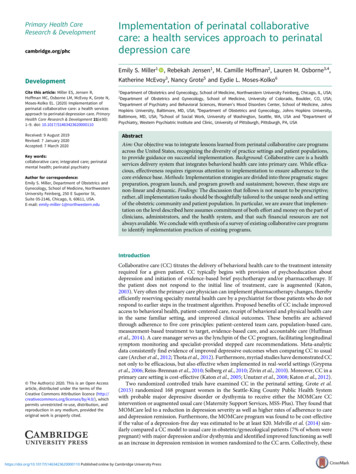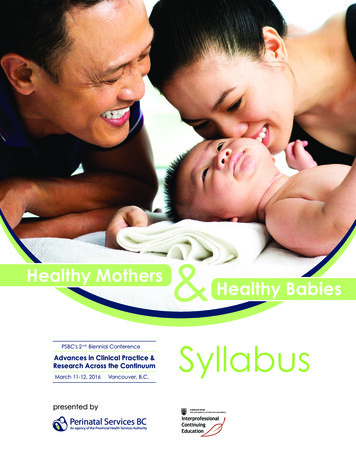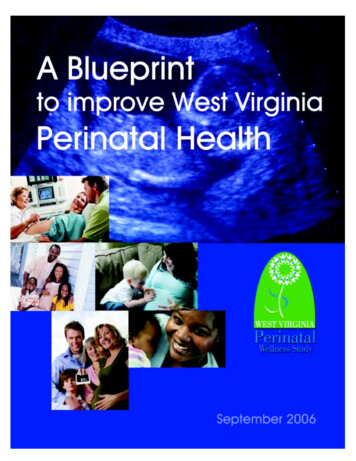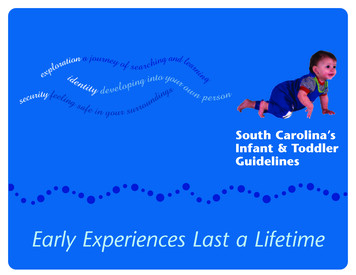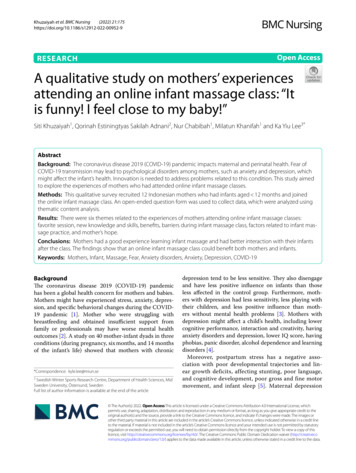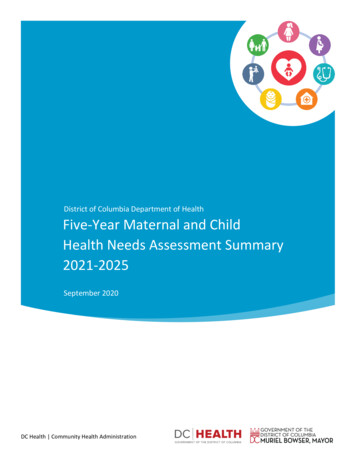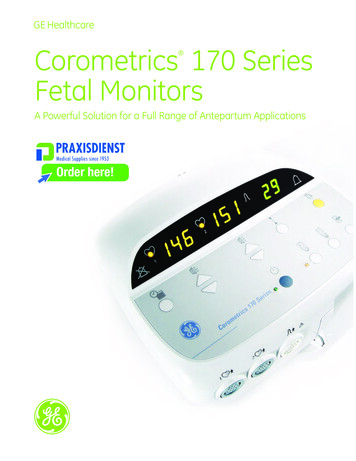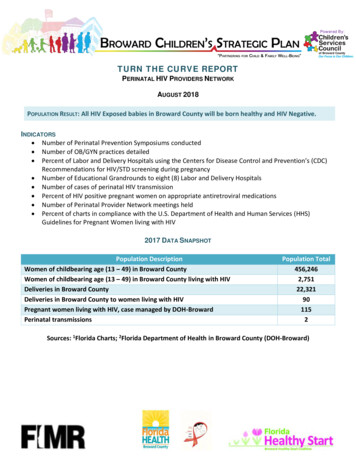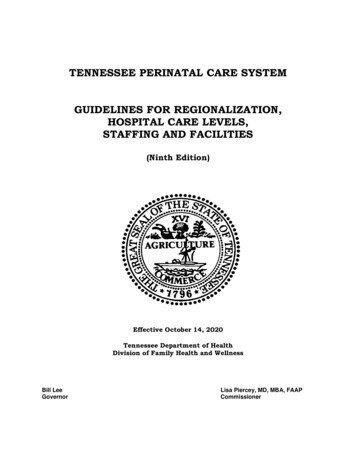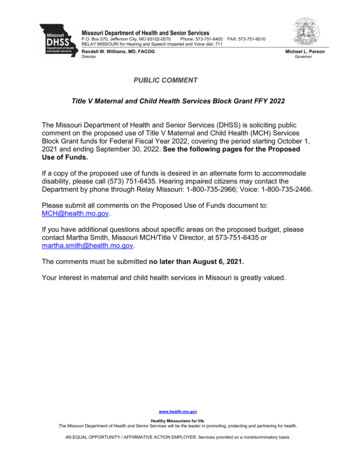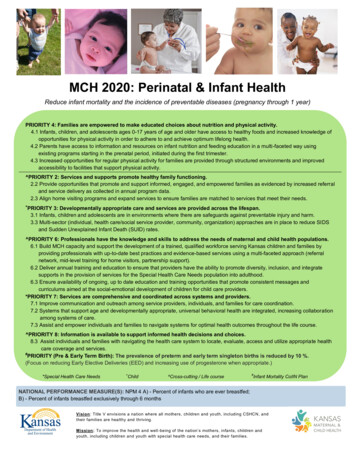
Transcription
MCH 2020: Perinatal & Infant HealthReduce infant mortality and the incidence of preventable diseases (pregnancy through 1 year)PRIORITY 4: Families are empowered to make educated choices about nutrition and physical activity.4.1 Infants, children, and adolescents ages 0-17 years of age and older have access to healthy foods and increased knowledge ofopportunities for physical activity in order to adhere to and achieve optimum lifelong health.4.2 Parents have access to information and resources on infant nutrition and feeding education in a multi-faceted way usingexisting programs starting in the prenatal period, initiated during the first trimester.4.3 Increased opportunities for regular physical activity for families are provided through structured environments and improvedaccessibility to facilities that support physical activity. PRIORITY 2: Services and supports promote healthy family functioning.2.2 Provide opportunities that promote and support informed, engaged, and empowered families as evidenced by increased referraland service delivery as collected in annual program data.2.3 Align home visiting programs and expand services to ensure families are matched to services that meet their needs. PRIORITY 3: Developmentally appropriate care and services are provided across the lifespan.3.1 Infants, children and adolescents are in environments where there are safeguards against preventable injury and harm.3.3 Multi-sector (individual, health care/social service provider, community, organization) approaches are in place to reduce SIDSand Sudden Unexplained Infant Death (SUID) rates. PRIORITY 6: Professionals have the knowledge and skills to address the needs of maternal and child health populations.6.1 Build MCH capacity and support the development of a trained, qualified workforce serving Kansas children and families byproviding professionals with up-to-date best practices and evidence-based services using a multi-faceted approach (referralnetwork, mid-level training for home visitors, partnership support).6.2 Deliver annual training and education to ensure that providers have the ability to promote diversity, inclusion, and integratesupports in the provision of services for the Special Health Care Needs population into adulthood.6.3 Ensure availability of ongoing, up to date education and training opportunities that promote consistent messages andcurriculums aimed at the social-emotional development of children for child care providers.*PRIORITY 7: Services are comprehensive and coordinated across systems and providers.7.1 Improve communication and outreach among service providers, individuals, and families for care coordination.7.2 Systems that support age and developmentally appropriate, universal behavioral health are integrated, increasing collaborationamong systems of care.7.3 Assist and empower individuals and families to navigate systems for optimal health outcomes throughout the life course. PRIORITY 8: Information is available to support informed health decisions and choices.8.3 Assist individuals and families with navigating the health care system to locate, evaluate, access and utilize appropriate healthcare coverage and services.#PRIORITY (Pre & Early Term Birth): The prevalence of preterm and early term singleton births is reduced by 10 %.(Focus on reducing Early Elective Deliveries (EED) and increasing use of progesterone when appropriate.)*Special Health Care Needs Child Cross-cutting / Life course#Infant Mortality CoIIN PlanNATIONAL PERFORMANCE MEASURE(S): NPM 4 A) - Percent of infants who are ever breastfed;B) - Percent of infants breastfed exclusively through 6 monthsVision: Title V envisions a nation where all mothers, children and youth, including CSHCN, andtheir families are healthy and thriving.Mission: To improve the health and well -being of the nation’s mothers, infants, children andyouth, including children and youth with special health care needs, and their families.
PERFORMANCE MEASURE 4A) Percent of infants who are ever breastfedandB) Percent of infants breastfed exclusivelythrough 6 monthsGOALTo increase the proportion of infants who are breastfed and whoare breastfed at six monthsDEFINITIONNumerator:A) Number of infants who were ever breastfedB) Number of infants breastfed exclusively through 6 monthsDenominator:A) Number of infants born in a calendar yearB) Number of infants born in a calendar yearUnits: 100HEALTHY PEOPLE 2020OBJECTIVEText: PercentRelated to Maternal, Infant, and Child Health (MICH) Objective21.1: Increase the proportion of children who are ever breastfed(Baseline: 74% in 2006, Target: 81.9%)Related to Maternal, Infant, and Child Health (MICH) Objective21.5: Increase the proportion of children who are breastfedexclusively at (Baseline: 14.1% in 2006, Target: 25.5%)DATA SOURCES and DATAISSUESA) National Immunization Survey (NIS)B) National Immunization Survey (NIS)MCH POPULATION DOMAINPerinatal/Infant HealthSIGNIFICANCEAdvantages of breastfeeding are indisputable. The AmericanAcademy of Pediatrics recommends all infants (includingpremature and sick newborns) exclusively breastfeed for aboutsix months as human milk supports optimal growth anddevelopment by providing all required nutrients during that time.Breastfeeding strengthens the immune system, improves normalimmune response to certain vaccines, offers possible protectionfrom allergies, and reduces probability of SIDS. Researchdemonstrates breastfed children may be less likely to developjuvenile diabetes; and may have a lower risk of developingchildhood obesity, and asthma; and tend to have fewer dentalcavities throughout life. The bond of a nursing mother and childis stronger than any other human contact. A woman's ability tomeet her child’s nutritional needs improves confidence andbonding with the baby and reduces feelings of anxiety and postnatal depression. Increased release of oxytocin whilebreastfeeding, leads to a reduction in post-partum hemorrhageand quicker return to a normal sized uterus over time, motherswho breastfeed may be less likely to develop breast, uterine andovarian cancer and have a reduced risk of developing79
INFANT MORTALITY COIIN: KANSAS LEARNING NETWORKSSMOKING CESSATIONPrimary focus: Reduce smoking before, during and/or after pregnancyAim/GoalsBy July 2016, we will reduce the rate of smoking in women in their reproductive years by 10% with emphasis onbefore, during, and after pregnancy. Increase the percentage of women who stop smoking during pregnancy by 10% Increase the percentage of women who maintain cessation after delivery by 10% Increase the number of women enrolled in Quitline in reproductive years (15-44 years of age) by 10% Increase the number of providers trained on the 5A's of tobacco cessation by 10%, implementing a providerreminder system and the KS Quitline fax referral system In pilot sites: Increase the percentage of smoking women who are referred to smoking cessation counseling andprograms like Quitline to 95% or higherProviders and support personnel refer women to evidence-based programs like Quitline (Driver 2)1. Screen for smoking at every visit and make referrals at the time of screeningo Cessation counselingo Evidence-based interventions (Ex: Quitline, SCRIPT, Baby and Me Tobacco Free programs)2. Follow up with women referred to stop smoking; inquire and refer again with advice3. Refer adolescents and college age women to evidence-based support services like QuitlinePrimary Drivers &Change IdeasWomen in child bearing years avoid smoking or stop and stay quit (Driver 4)1. Leverage consistent, repeat messages about tobacco and nicotine across all systems2. Use media, social media, texting, videos, peer to peer mentoring3. Use of 5As and motivational interviewing techniques to help women commit to cessationProviders recognize role in coaching and supporting women to stop and stay quit (Driver 5)1. Train providers in smoking interventions and aware of resources/interventions2. Place toolkits (screening, referral, resources, programs) in the hands of providers3. Enlist support of pediatricians to inquire about smoking, counseling, referrals postpartumState MeasuresOutcome Measures Smoking Cessation Prior to Pregnancy Smoking Cessation During Pregnancy
Percentage of women who report smoking during pregnancyNumber of enrolled women Quitline participants, in childbearing years, who report cessation at 7th month afterenrollment (in States where Quitline collects this data)Disparity reduction in all 5 outcome measuresProcess Measures Number of enrolled Quitline participants in childbearing yearsOutcome Measures % Pregnant women referred to Quitline who report they quit smoking at clinic visit % Women with continued cessation at post-partum visitProcess Measures % Quitline Referrals % Pregnant Women Counseled by Pilot Site to Quit % Engagement of Women who Smoke % Home Visitation Referrals by ClinicPilot MeasuresPRE/EARLY TERM BIRTHPrimary focus: Increase appropriate utilization of progesterone and/or reduce early elective deliveriesAim/GoalsPrimary Drivers &Change IdeasBy July 2016, reduce prevalence of preterm and early term singleton births by 10 %. Decrease non-medically indicated births between 37 0/7 weeks of gestation through 38 6/7 weeks of gestationto less than 5% Increase the percent of pregnant women on Medicaid with a previous preterm birth who receive progesterone to40% Achieve or maintain equity in utilization of progesterone by race/ethnicity Increase the number of Healthy Babies are Worth the Wait/Becoming a Mom (HBWW/BAM) sites by at least 5Timely, reliable and effective screening, identification and prevention of pre-term birth (Driver 1)1. Universal practice protocol and tool to screen women for history of preterm birth and short cervix2. Establish universal process for early access to care3. Use claims data and data linkages to increase the number of women prescribed progesteroneIncrease patient, family and community understanding of progesterone and full term births (Driver 3)
1. Integrate early elective delivery (EED) and progesterone education/materials into HBWW/BAM2. Integrate screening and referral to BAM into WIC—intake, appointment interviews, data collected3. Utilize existing blogs, websites and text messaging, such as Healthy Mom and Baby, March of Dimes ShareYour Story and CineMama, and Text4Baby to provide information on progesteroneBuild capacity of and support for hospitals and providers to reduce EED (Driver 5)1. Standard forms for scheduling that collect gestational age and indication for delivery (to determine medicallyindicated)2. Standard tool, process, reporting system for EED3. Standard protocol and/or policies (hard stop, scheduling process/form, informed consent, flow charts, etc.State MeasuresPilot MeasuresOutcome Measures Initiation of Progesterone in Women with Prior Preterm Birth Early Term Birth Rate Non-medically indicated, early elective delivery Stillbirth Rate (Balancing Measure)Process Measures Preterm Birth Risk Screening: Cervical Length Preterm Birth Risk Screening: Prior Preterm Birth Prescription for Progesterone Progesterone and Home Visiting Expected Delivery Date at Time Delivery is ScheduledFirst Pilot Sites: Pre/Early Term Birth: Sedgwick County (Associates in Women’s Health OBGYN); Geary County (Flint Hills OBGYN);Smoking Cessation: Sedgwick County HD WIC clinic; Saline County HD & collaborative partners; Crawford County HD & collaborative partners*The United States has one of the highest rates of infant mortality of all industrialized nations. On average, 6.15 out of every 1,000 babies born in the US die before their firstbirthday, based on 2010 statistics. This compares with an average of 5.0 for all other industrialized nations. Minority populations are disproportionately affected: the risk of infantdeath for babies born to non-Hispanic black women is more than two times greater than the risk of infant death for non-Hispanic white women. In 2013, US Department of Healthand Human Services (HHS) Secretary, Kathleen Sebelius, announced the nation’s first national strategy to reduce infant mortality. The Infant Mortality Collaborative Improvementand Innovation Network (CoIIN) Expansion is a key component of this strategy. A collaborative innovation network, or COIN, is a “cyberteam of self-motivated people with acollective vision, that innovatively collaborate by sharing ideas, information, and work enabled by technology.” For more information, visit HRSA/MCHB website at:http://mchb.hrsa.gov/infantmortality/coiin/.
6.1 Build MCH capacity and support the development of a trained, qualified workforce serving Kansas children and families by providing professionals with up-to-date best practices and evidence-based services using a multi-faceted approach (referral network, mid-level training for home visitors, partnership support).

